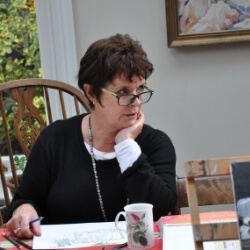 Caroline is Landmark's Historian. She has been involved in the Llwyn Celyn project for over 10 years, first visiting the site in 2007 when it was covered in emergency scaffolding.
Caroline is Landmark's Historian. She has been involved in the Llwyn Celyn project for over 10 years, first visiting the site in 2007 when it was covered in emergency scaffolding.
What is your role at Landmark? What is your role at Llwyn Celyn?
I’ve been Landmark’s Historian since 2001. People are always interested in our buildings’ histories. Llwyn Celyn has involved both strands to the max, with lots of historical puzzles to untease as well as a very extensive, Heritage Lottery Funded engagement programme in the Llanthony Valley that I’ve delivered with Landmark's Engagement Manager.
How long have you been involved with the Llwyn Celyn project?
I can hardly believe that it was eleven years ago, in 2007, that I first visited Llwyn Celyn! I also lead on Landmark’s search for potential projects, so am often among the first to see a potential Landmark. We’re used to taking a long view, but Llwyn Celyn was an unusually complex project to acquire and then restore. Today, Llwyn Celyn shines like a white beacon at the entrance to the Llanthony Valley, but back then it was shrouded in emergency scaffolding and torn sheeting. Water was running off the hillside through some of the rooms and the roof was leaking badly. There was an interesting moment on that first visit when our chairman’s foot went through a rotten upstairs floorboard! To be able to see a project through from such dereliction to the welcoming, evocative spaces that we see today is one of the main satisfactions of working at Landmark.
What was the most interesting thing you discovered at Llwyn Celyn?
We made lots of interesting discoveries on-site during the restoration works, but the best moment for me was when the UK Oak Project at Swansea and Oxford Universities provided a construction date of c1420 for the main house, using their ground-breaking analysis of oxygen isotopes in timbers from the house. As a documentary historian, stylistic dating of the fabric to ‘sometime in the late-15th century’ isn’t that helpful, especially in a period when primary sources are still pretty scarce. 1420 was 60 years earlier than we had thought, and is incredibly early date for a house to survive in Wales because of the widespread destruction by both sides in Owain Glyn Dwr’s Rising of 1400-1415. We knew all along that Llwyn Celyn was exceptional, but a date as early as this really confirmed that judgement, and justified all the hard work the entire team put in to find a way to rescue it. Once we had that date, we could really begin to build up a picture of the context surrounding Llwyn Celyn’s construction.
What was the biggest challenge at Llwyn Celyn?
Probably raising the money to restore it in the first place. At a technical level, I always have great faith in so many wonderful colleagues, consultants and craftsmen, knowing that they can pull off the actual restoration works – but rescuing a building in such genuine peril is always expensive. At Llwyn Celyn, we were incredibly fortunate to receive a grant for 57% of the costs from the Heritage Lottery Fund, but that still left 43% to find from other sources. It’s another great source of happiness for us that we have so many wonderful supporters who are willing to travel the journey with us, and through their donations enable us to carry through on our conviction that places such as Llwyn Celyn can and should be saved.
What is one thing that people may not know about Llwyn Celyn?
That it’s still ‘guarded from evil spirits’ by the 17th-century shoe we found carefully concealed under the north eaves of the hall. We found it during our re-roofing. It was probably placed there by William Watkin, when he was modernising the house in the 1690s (another firm date we have the UK Oak Project to thank for). So yes, we’ve put it back!
Do you have any advice for anyone wanting to enter the heritage/building conservation industry?
Volunteering always helps, but to get beyond volunteering, pursue your specific areas of interest, and work out what particular specialism you can bring – the heritage industry needs everything from IT specialists, to fundraisers, to communicators as well as building experts and historical specialists. A professional qualification of some kind can also help you stand out from the crowd.
What is your favourite Landmark?
I always find this an impossible question to answer, because my favourite is honestly always the one I’m currently researching. So right now it’s Llwyn Celyn – until the next one!